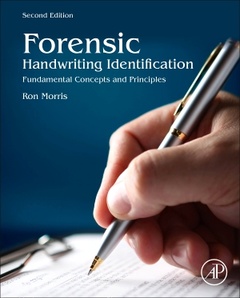Forensic Handwriting Identification (2nd Ed.) Fundamental Concepts and Principles
Auteur : Morris Ron N.

1. Physiology of Writing2. Handwriting Systems3. Class Characteristics4. Individuality and Individual Characteristics5. Characteristics, Qualities, and Features of Writing6. Relative Speed of Writing and Writing Skill7. Ratios or Relative Relationships8. Beginning, Connecting and Ending Strokes9. Writing Instruments10. General Observations11. The Process of Comparison12. Abnormal/Disguised Writing13. Obtaining Handwriting Samples14. Submitting a case to the lab15. Examiner’s Final Report
Forensic and legal professionals, investigators working with document examiners, law enforcement students and professionals
- Reviews basic concepts that affect a person’s writing, demonstrates how to obtain handwriting specimens and evidence, and provides the appropriate ASTM and SWIGDOC standards and procedures
- Ideally suited for forensic science and legal professionals, investigators working with document examiners, and law enforcement students and professionals
- Includes model specimen handwriting forms
Date de parution : 11-2020
Ouvrage de 320 p.
19x23.3 cm
Thème de Forensic Handwriting Identification :
Mots-clés :
Ballpoint; Book; Characteristics; Comprehensive examination; Copybook; Disguised writing; Document; Examination; Fabrication; Features of writing; Forensic Document Examiner; Forensic Document Examiners; Graphic maturity; Hand printing; Handprinting; Handwriting; Handwriting rules; Handwriting samples; Handwriting systems; Language; Languages; Letter; Letters; Material; Paper; Pen; Penman; Photocopier; Photocopy; Process of comparison; Qualities; Questioned writing; Random; Relative speed; Specimen; Stroke; SWGDOC; System; Writer; Writers; Writing; Writing instrument; Writing position; Writing skills; Writing system; Writings; Xerox



